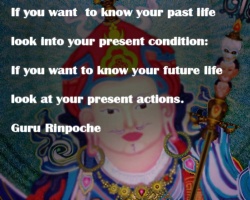Difference between revisions of "Kuon-ganjo"
(Created page with " kuon-ganjo 久遠元初 ( Jpn) Literally kuon means the remote past, and ganjo, beginning or foundation. This term appears in On the Mystic Princi...") |
|||
| Line 1: | Line 1: | ||
| − | + | <nomobile>{{DisplayImages|774|4435|3388}}</nomobile> | |
[[kuon-ganjo]] | [[kuon-ganjo]] | ||
[[久遠元初]] ( Jpn) | [[久遠元初]] ( Jpn) | ||
| − | Literally [[kuon]] means the [[remote past]], and [[ganjo]], [[beginning or foundation]]. This term appears in On the | + | Literally [[kuon]] means the [[remote past]], and [[ganjo]], [[beginning or foundation]]. This term appears in [[On the Mystic Principle of the True Cause]], a work written by [[Nichiren]] in 1282. |
| − | + | This work refers to "the [[Mystic Law]], uncreated and eternal, of the [[Buddha of beginningless time]] ([[kuonganjo]]), " and states that the [[Mystic Law]] lies in the depths of the "[[Life Span]]" (sixteenth) [[chapter]] of the [[Lotus Sutra]]. | |
| − | + | [[Nichiren]] interprets [[kuonganjo]] on two different levels: | |
| − | " | + | (1) In the context of the "[[Life Span]]" [[chapter]], kuon refers to the remote {{Wiki|past}} when [[Shakyamuni]] originally [[attained]] [[enlightenment]], and [[ganjo]], to the foundation of his [[original enlightenment]]. |
| − | + | (2) In The [[Record of the Orally Transmitted Teachings]], [[Nichiren's]] [[oral teachings]] on the [[Lotus Sutra]] compiled by [[Nikkoin]] 1278, it is stated: | |
| − | The same section of Orally Transmitted Teachings concludes, "Kuon is [[Nam-myoho-renge-kyo]], and ' | + | "[[Kuon]] means something that was not worked for, that was not improved upon, but that [[exists]] just as it always has." [[Orally Transmitted Teachings]] continues: "Because we are {{Wiki|speaking}} here of the [[Buddha]] eternally endowed with the [[three bodies]], it is not a question of something [[attained]] for the first time at a certain time, or of something that was worked for. |
| + | |||
| + | This is not the kind of [[Buddhahood]] that is adorned with the [[thirty-two features]] and [[eighty characteristics]] or that needs to be improved on in any way. Because this is the eternal and immutable [[Buddha]] in his original [[state]], he [[exists]] just as he always has. This is what is meant by [[kuon]]." | ||
| + | |||
| + | The same section of [[Orally Transmitted Teachings]] concludes, "[[Kuon]] is [[Nam-myoho-renge-kyo]], and '[[true attainment]]' means [[awakening]] to the fact that one is eternally endowed with the [[three bodies]]." | ||
| + | |||
| + | In [[essence]], for [[Nichiren]], [[kuon]], or [[kuonganjo]], means the eternal Law of [[Nam-myoho-renge-kyo]] and the original [[state]] of [[life]] that [[embodies]] [[Buddhahood]]. | ||
| + | {{R}} | ||
| + | [http://www.sgilibrary.org/search_dict.php?SearchSelect=dict&p=14&m=1&in=2&q=buddha] | ||
| + | {{JapaneseTerminology}} | ||
| + | [[Category:Japanese Buddhism]] | ||
Latest revision as of 10:58, 21 September 2015
kuon-ganjo 久遠元初 ( Jpn)
Literally kuon means the remote past, and ganjo, beginning or foundation. This term appears in On the Mystic Principle of the True Cause, a work written by Nichiren in 1282.
This work refers to "the Mystic Law, uncreated and eternal, of the Buddha of beginningless time (kuonganjo), " and states that the Mystic Law lies in the depths of the "Life Span" (sixteenth) chapter of the Lotus Sutra.
Nichiren interprets kuonganjo on two different levels:
(1) In the context of the "Life Span" chapter, kuon refers to the remote past when Shakyamuni originally attained enlightenment, and ganjo, to the foundation of his original enlightenment.
(2) In The Record of the Orally Transmitted Teachings, Nichiren's oral teachings on the Lotus Sutra compiled by Nikkoin 1278, it is stated:
"Kuon means something that was not worked for, that was not improved upon, but that exists just as it always has." Orally Transmitted Teachings continues: "Because we are speaking here of the Buddha eternally endowed with the three bodies, it is not a question of something attained for the first time at a certain time, or of something that was worked for.
This is not the kind of Buddhahood that is adorned with the thirty-two features and eighty characteristics or that needs to be improved on in any way. Because this is the eternal and immutable Buddha in his original state, he exists just as he always has. This is what is meant by kuon."
The same section of Orally Transmitted Teachings concludes, "Kuon is Nam-myoho-renge-kyo, and 'true attainment' means awakening to the fact that one is eternally endowed with the three bodies."
In essence, for Nichiren, kuon, or kuonganjo, means the eternal Law of Nam-myoho-renge-kyo and the original state of life that embodies Buddhahood.


